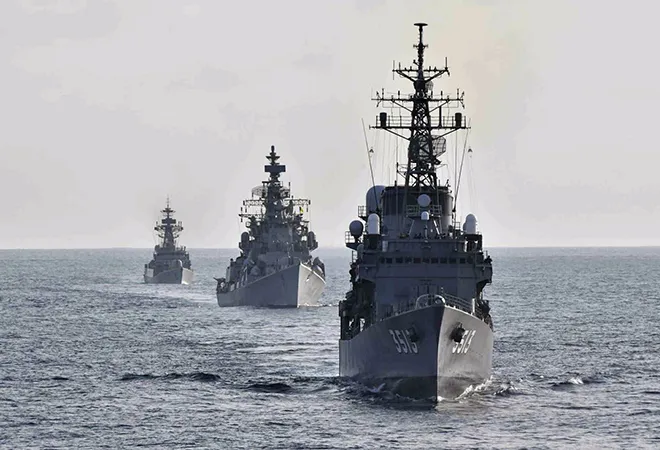-
CENTRES
Progammes & Centres
Location
Maritime security in the Bay of Bengal can provide ground for convergence among European players and India, especially in the Indo-Pacific context

In recent years, several key European players such as France, the United Kingdom (UK), Germany, and Italy have cemented their ties with India in the Indo-Pacific context. While India’s engagement with like-minded partners in Europe has grown in the Indian Ocean maritime geography, the Bay of Bengal region, which is critical to New Delhi’s security and strategic calculus, continues to remain a marginal space for India-Europe engagement. Here, it is argued that with a growing focus on trade and connectivity in the Indo-Pacific and growing engagements between European players and the Bay of Bengal littoral states, maritime security is likely to emerge as a critical domain of convergence between India and Europe in the Bay of Bengal.
Positioning the Bay of Bengal in the Indo-Pacific
The Bay of Bengal region has increasingly emerged as a critical theatre in shaping the evolving geopolitics in the Indo-Pacific. It connects India and Southeast Asia—two pivots around which the geopolitics of the Indo-Pacific continues to evolve. While the Bay of Bengal is located between India and Thailand in the Indian Ocean, Bangladesh, Myanmar, and Sri Lanka are the key littoral states, accounting for a sizable global market and economy. The largest bay in the world, the Bay of Bengal is fast emerging as a critical area of economic and strategic competition in the Indo-Pacific context. Increasingly, India’s engagement in the Bay of Bengal has been viewed as a key driver of its broader Indo-Pacific outlook. India’s flagship naval engagements in the Bay with its partners in the Quad—a regional grouping comprising India, the United States, Japan and Australia—demonstrate the significance accorded to the region in the broader Indo-Pacific context. In contrast to this, the Bay of Bengal region continues to remain a marginal aspect of Europe’s engagement in the Indo-Pacific.
The largest bay in the world, the Bay of Bengal is fast emerging as a critical area of economic and strategic competition in the Indo-Pacific context.
Europe and the Bay of Bengal
The Bay of Bengal, however, is not a novel maritime geography in Europe’s strategic calculus. Historically, the arrival of the European powers in the Bay of Bengal connected the region to global markets. More recently, with the adoption of the Indo-Pacific as an integrated space, Europe’s interests in the region are increasingly focused on trade, connectivity and, therefore, maritime security. From being an erstwhile colonial power in the region, France has sought to be viewed as a resident power of the Indo-Pacific, thereby aligning its strategic calculus with the geographical expanse of the region. Therefore, it is important to map out scopes and areas that might be critical in the convergence of interests between India and its European partners in the Bay of Bengal that are likely to strengthen their Indo-Pacific outlook. Towards this end, it may be argued that following the enhanced focus on trade and connectivity in the Indo-Pacific, European players are likely to shift their focus towards the Bay of Bengal as they deepen their engagements with regional littoral countries. This would further require European players to focus on maritime security in the region, resulting in a convergence of interests with India.
Locating the scope of converging maritime security interests
As India cements its Indo-Pacific outlook, the significance of the Bay of Bengal has enhanced manifold. Importantly, the centrality accorded to ASEAN in India’s Indo-Pacific outlook makes it imperative for the Bay of Bengal to be viewed as a critical strategic theatre in engaging with Southeast Asia, owing to the historical cultural ties, and more recently, strategic complementarities established by New Delhi.
Further, in the Indo-Pacific context, India and Europe have identified and worked towards establishing strategic convergences. With Europe’s shifting focus towards this region, the need for security in the maritime domain has generated significant policy focus among European powers. With India keen on securing the Bay, greater involvement of European players will develop as the Bay emerges as a key theatre in facilitating Europe’s trade and connectivity.
From being an erstwhile colonial power in the region, France has sought to be viewed as a resident power of the Indo-Pacific, thereby aligning its strategic calculus with the geographical expanse of the region.
For India, the geographical imperative is a lynchpin for its engagement in the Bay of Bengal. Historically, much of India’s economic, cultural, and ideational exchanges have been facilitated by the Bay of Bengal. Even today, India’s maritime borders on the eastern coast are key to its increasing sea-borne trade. However, more importantly, as strategic competition between India and China intensifies in the Indian Ocean, the Bay of Bengal is likely to evolve as a critical maritime geography for India. China’s involvement in developmental projects in India’s littoral neighbourhood, particularly in Sri Lanka, Bangladesh, and Myanmar, has raised suspicion in New Delhi. In this context, maritime security has become an urgent priority for India. New Delhi’s shifting focus to the Bay of Bengal as a space for maritime exercises with like-minded partner countries, as well as propelling naval diplomacy as a key tool of its outreach in its maritime neighbourhood, exhibit its keen interest and focus on securing the Bay of Bengal.
For Europe, the economic potential of the Indo-Pacific is the central pillar of its engagement with the region. Undoubtedly, Europe is currently going through a period of crisis with the prolonged Russia-Ukraine conflict. The effects of the conflict have been felt world over, especially economically, with the energy market fluctuating. As a result, there is a need for Europe to diversify its engagements, especially in crucial areas such as trade and food and energy security. The European Union has defined the Indo-Pacific as ‘vital’ owing to its ‘growing economic, demographic and political weight’. However, the critical strategic theatre of the Bay of Bengal region has remained absent from Europe’s Indo-Pacific outlook. This, however, will need to be addressed as Europe deepens and expands its engagements with the Bay of Bengal littoral states to drive its Indo-Pacific outlook.
Among the major European players in the Indo-Pacific, France is the only country that has entered the Bay of Bengal strategic theatre. Arguably, among other European players, India shares the greatest degree of synergy with France in the Indo-Pacific. In 2021, India and France demonstrated this in the domain of maritime security in the Bay of Bengal with India’s maiden participation in the La Perouse exercise. The French-led naval exercise brought together the four Quad countries in the Bay of Bengal to perform complex and advanced naval operations and showcased high levels of coordination and interoperability. Further, in 2023, La Perouse witnessed the participation of the UK in the Bay of Bengal region.
India and France demonstrated this in the domain of maritime security in the Bay of Bengal with India’s maiden participation in the La Perouse exercise.
For this analysis, the focus may be shifted towards three leading European players in the Indo-Pacific—France, the UK, and Italy. Some potential areas of convergence between these countries and India may be pointed out in this context.
Conclusion
Europe’s presence in the Bay of Bengal region continues to remain marginal. However, given their enhanced focus on the Indo-Pacific and growing cooperation with India and other Bay of Bengal littoral states, it is likely that the Bay will emerge as an area of priority for European players. For India, maritime security in the Bay of Bengal will continue to remain a top priority due to the geographic imperative of its location, but for Europe, the Bay of Bengal is likely to be gradually important in tandem with their Indo-Pacific engagements. So, even though the strategic environment in the Bay of Bengal poses varying kinds of concerns for India and European countries, the need to secure the region and ensure peace and stability in the wider Indo-Pacific lie at the heart of their respective strategic outlooks in the region.
For India, maritime security in the Bay of Bengal will continue to remain a top priority due to the geographic imperative of its location, but for Europe, the Bay of Bengal is likely to be gradually important in tandem with their Indo-Pacific engagements.
However, given the historical past and the role played by European powers during their erstwhile colonial expansion and its prolonged implications in altering Indian Ocean geopolitics, it would be helpful if policymakers in Europe are mindful while crafting their role in the region and seeking closer ties with India. Additionally, policymakers in India as well as Europe should carefully track Chinese President Xi’s recent meeting with Russian President Putin and the potential of an emerging China-Russia axis.
Nonetheless, with Europe’s growing strategic focus on the Indo-Pacific and deepening cooperation with regional players, maritime security in the Bay of Bengal is surely going to provide ground for convergence among European players and India.
The views expressed above belong to the author(s). ORF research and analyses now available on Telegram! Click here to access our curated content — blogs, longforms and interviews.

Sayantan Haldar is a Research Assistant at ORF’s Strategic Studies Programme. At ORF, Sayantan’s research focuses on Maritime Studies. He is interested in questions of ...
Read More +